3.2
Impact Factor
ISSN: 1837-9664
J Cancer 2018; 9(17):3038-3045. doi:10.7150/jca.26278 This issue Cite
Research Paper
The cost of hospital treatment of advanced stage lung cancer patients in a developing South East European country
1. Institute for pulmonary diseases of Vojvodina, Faculty of Medicine, University of Novi Sad, Serbia
2. University Educons, Sremska Kamenica, Serbia
3. 3rd Department of Surgery, ''AHEPA'' University Hospital, Aristotle University of Thessaloniki, Medical School, Thessaloniki, Greece
4. Anesthesiology Department, ''AHEPA'' University General Hospital, Aristotle University of Thessaloniki, Thessaloniki, Greece
5. Thoracic Surgery Department, University General Hospital of Alexandroupolis, Democritus University of Thrace, Alexandroupolis, Greece
6. Department of Pharmacology & Clinical Pharmacology, School of Medicine, Faculty of Health Sciences, Aristotle University of Thessaloniki, Thessaloniki, Greece
7. Department of Respiratory & Critical Care Medicine, Changhai Hospital, the Second Military Medical University, Shanghai, 200433, China
* Authors contributed equally to this work.
Received 2018-3-25; Accepted 2018-6-9; Published 2018-7-30
Abstract
Assessing the lung cancer treatment costs is necessary in order to estimate the budget impact of new interventions and therapeutic innovations. However, there are few studies regarding the use of resources and costs associated with treatment of lung cancer patients, not only in Serbia, but internationally. The aim of this paper was to assess the hospital costs of diagnosing and treating patients with stage IIIB and IV non-small cell lung cancer. Analysis of costs of care, services, medications and medical supplies, as well as of total hospital costs, was performed. Patients diagnosed with stage IIIB or IV NSCLC in the Institute during the year 2013 were enrolled in the study. A total of 187 patients with stage IIIB or IV NSCLC were analyzed. Total hospital costs were 506.970€, of which nearly two thirds was accounted to costs of services and medications. The mean cost per patient with adenocarcinoma was 3.075€, and for squamous cell lung carcinoma patient 1.943€. Statistically significant difference was shown when comparing mean hospital costs between patients in stage IIIB and stage IV adenocarcinoma, where this cost is higher in patients with stage IIIB. Mean hospital cost per female patient was nearly double as high that of the male patients, although without statistically significant difference. The mean cost for all adenocarcinoma patients was 1.317€, and for only four patients treated with TKI therapy 21.233€. This cost analysis could provide useful information in terms of budget impact of different lung cancer treatments and innovations in Serbia and corresponding developing countries.
Keywords: Lung cancer, Non-small cell lung cancer (NSCLC), EGFR, Health economics, Hospital costs
Background
Lung cancer has been the most common cancer in the world for several decades. There were 1.79 million new cases in 2013, which stands for 12% of all new cancer cases. What is of more importance is that the mortality of lung cancer is very high, resulting in 1.64 million deaths all around the world in 2013, which is 20% of all cancer deaths.[1] In Europe, lung cancer is the first cause of death from cancer in men and the third in women. The trend of lung cancer incidence is expected to rise over the next three decades, thus placing lung cancer in the third place as an overall cause of mortality.[2] Lung cancer is also the leading cancer in Serbia, with very high incidence of 45.6 (age-standardized rate per 100.000), which puts the country on the second place in the list of countries with the highest rate of lung cancer.[3]
Close to 70 percent of lung cancer patients present with advanced or metastatic disease at the time of diagnosis, which can explain the low relative survival rate of 15% at 5 years.[4] In the Institute for pulmonary diseases of Vojvodina, where this study was conducted, the percentage of patients who are diagnosed with stage IIIB or IV lung cancer is nearly 70%. Since the mortality of this disease is on a very high level, huge efforts have been deployed in development and implementation of the new diagnostic tools and procedures, as well as in the field of drug development. Novel diagnostic approaches and emerging drugs have significantly changed the management of patients with lung cancer over the last 10 years. The consequence of that is an increase in healthcare costs, where aggregated annual direct costs of lung cancer for EU countries in 2011 were 3.35 billion €.[5] This rise of healthcare costs is of great importance, and the cause of it is not only the probable increase in the percentage of the incidence and deaths due to lung cancer in the forthcoming decades from 3.9% in 2008 to 4.1% in 2030 (projected proportion)[6], but also the expensiveness of the novel drugs, at least as far as the cost of these drugs are so high. It is even more important for the developing countries with less financial support for healthcare.
The aforementioned emphasizes the financial and economical side when it comes to the matter of patients' diagnosis and treatment. This is especially important in the treatment of patients who were diagnosed with advanced stages of the disease, as well as of those diagnosed with non-small cell lung cancer (NSCLC). Besides the fact that NSCLC occurs in more than 85% of all lung cancer cases [7], costs of treating patients diagnosed with this disease are found to be higher than in patients with small-cell lung cancer (SCLC).[8]
During the last few decades, chemotherapy has been widely used to treat NSCLC patients. More recently, new, less toxic, but more expensive drugs that are more convenient to administer have become available. [9, 10] This creates a significant economic burden that lung cancer patients often produce as a result of their treatment, which makes it critical for regulatory and medical insurance organizations to collect and utilize data to estimate the costs and cost-effectiveness of these treatments. So far, there have been no comprehensive studies on resource use and costs associated with lung cancer patients in clinical practice in Serbia, nor in surrounding low income countries with similar healthcare systems.
The aim of this research was to collect healthcare costs associated with treating advanced non-small cell lung cancer (NSCLC) patients in a tertiary healthcare hospital, with intention to estimate the economic burden of this disease for the healthcare system in Serbia.
Patients and Methods
Patients
During 2013 there were 1271 patients who were diagnosed with lung cancer at the Institute for pulmonary diseases of Vojvodina. Out this number, 445 of them were from the district of Južna Bačka, which means that they were both diagnosed and treated at the Institute, which serves as tertiary institution for this district. Inclusion criteria for enrollment in this trial were: histologically or cytologically confirmed diagnosis of non-small cell lung cancer (NSCLC), stage IIIB or IV, the ability and willingness to be completely treated at the Institute. The exclusion criteria were: diagnosis of small cell lung cancer, NSCLC stage I-IIIA, inability to receive complete treatment at the Institute. Total number of 187 patients fulfilled all the previously mentioned criteria, and those patients were enrolled in study. The data concerning their treatment, as well as the hospital costs that those treatments produced, were collected during the period of 30 months (1.1.2013.-30.6.2015.). Figure 1 shows the patient flowchart.
Patient flowchart.
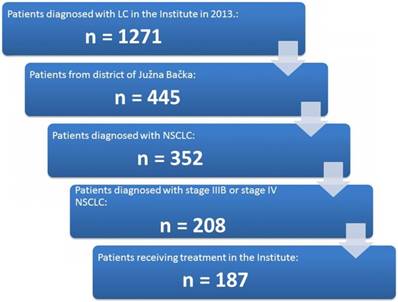
Methods
Institute for pulmonary diseases of Vojvodina has its own Integrated Hospital Information System, which can be accepted as a population register, because it is covering more than 90% of patients with lung cancer in the province of Vojvodina. The analysis was performed regarding the data collection from the above mentioned system, where the procedures and resources recorded in the system were extracted, and then the list cost for procedures and resources was used to estimate the cost for each patient. For the statistical analysis the SPSS 20.0 was used (Kruskal Wallis test - for economic analysis, Kaplan Meier survival and Log Rank test (Mantel-Cox) for survival analysis). Cost analysis includes a time period beginning with the patients' first appointment at the Institute, and ending with 30.06.2015., or earlier in case of patients' death. All the costs which occurred in this time frame were calculated according to the current pricelist of National Health Insurance Fond of Serbia, which is incorporated in Institutes' Information system, and were converted into Euro according to the official middle exchange rate of the dinar against the euro, published by National Bank of Serbia on 30.06.2015.
Total hospital costs were divided into four categories: care, services, medications and medical supply. Costs of care included daily bed costs (accommodation, food, energents and other non medical costs. Costs of services included costs of diagnostic procedures, such as bronchoscopy, X-ray, CT and PET scan, laboratory tests and all others. Costs of medication included costs of all drugs that were given to the patients during their hospitalization. Costs of medical supplies included costs of all supplies necessary for diagnostic and therapy procedures (for example: gloves, needles, syringes etc.).
Costs were analyzed and presented in the first month of the patients' treatment, where diagnostics constitutes the largest part of those costs, and in the other months, collectively. Costs per unit of time were not analyzed, because the focus was on the average patient costs, regardless of the time of their treatment. Patients were divided into groups, depending on their gender (male or female), age (≤65 or >65), lung cancer histologic type (squamous cell carcinoma, adenocarcinoma or large cell carcinoma), lung cancer stage (IIIB or stage IV NSCLC), treatment scheme (cisplatin/etoposide, cisplatin/gemcitabine, paclitaxel/carboplatin, vinorelbine/gemcitabine, gefitinib or erlotinib) and those who were alive after the end of the study (for patients with squamous cell carcinoma, adenocarcinoma and large cell carcinoma).
Results
Patient characteristics and survival rate
A total of 187 cases of lung cancer were analyzed, of which the majority were male patients (73.3%), over 65 years of age (58.29%), mostly with adenocarcinoma (65.8%) and stage IV NSCLC (63.1%). Table 1 describes gender, age, histologic type and stage of lung cancer, as well as the received treatments, in the first line setting.
The mean and median survival time concerning histologic type of lung cancer, gender and stage of the lung cancer are given in Table 2. The results of Log Rank test show that there is no statistical significance between histologic type of lung cancer and survival time of the patients. However, as far as gender and stage of the cancer are concerned, statistical significance is present in both cases. Figure 2 shows Kaplan-Meier survival curve in relation to gender, while Figure 3 shows Kaplan-Meier survival curve in relation to the stage. Figure 4 reveals Kaplan-Meier survival curve in relation to histology type of lung cancer.
Kaplan-Meier survival functions for gender
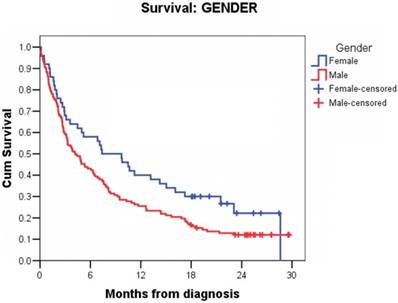
Kaplan-Meier survival functions for lung cancer stage

Kaplan-Meier survival functions for type of lung cancer
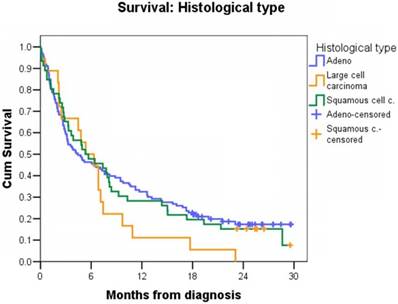
Patient characteristics
| Patient characteristics | N (%) |
|---|---|
| Gender | |
| Male | 137 (73.3) |
| Female | 50 (26.7) |
| Age (years) | |
| ≤65 | 78 (41.71) |
| >65 | 109 (58.29) |
| Histologic type | |
| Squamous cell carcinoma | 46 (24.6) |
| Adenocarcinoma | 123 (65.8) |
| Large cell carcinoma | 18 (9.6) |
| Stage | |
| Stage IIIB NSCLC | 69 (36.9) |
| Stage IV NSCLC | 118 (63.1) |
| Treatment scheme | |
| Cisplatin/Etoposide | 14 (7.5) |
| Cisplatin/Gemcitabine | 133 (71.1) |
| Paclitaxel/Carboplatin | 29 (15.5) |
| Vinorelbine/Gemcitabine | 7 (3.7) |
| Gefitinib | 2 (1.1) |
| Erlotinib | 2 (1.1) |
| Alive after 30 months | |
| Squamous cell carcinoma | 6 (13%)* |
| Adenocarcinoma | 23 (18.7%)* |
| Large cell carcinoma | 0 (0%)* |
*out of the total number of patients with appropriate histologic type of cancer
Mean and median survival time (in months)
| Histologic type | Mean (sd) | Median (sd) | Log Rank test (Mantel-Cox) p-value |
|---|---|---|---|
| Squamous cell carcinoma | 9.5 (1.4) | 5.3 (1.9) | 0.403 |
| Adenocarcinoma | 10 (0.9) | 4.4 (1.3) | |
| Large cell carcinoma | 6.7 (1.3) | 5.3 (1.6) | |
| Overall | 9.6 (0.7) | 4.9 (0.9) | |
| Gender | Mean (sd) | Median (sd) | Log Rank test (Mantel-Cox) p-value |
| Male | 8.6 (0.8) | 4.2 (0.7) | 0.045 |
| Female | 12.1 (1.5) | 7.4 (2.1) | |
| Overall | 9.6 (0.7) | 4.9 (0.9) | |
| Stage | Mean (sd) | Median (sd) | Log Rank test (Mantel-Cox) p-value |
| Stage IIIB | 12.1 (1.3) | 7.4 (1.2) | 0.009 |
| Stage IV | 8.1 (0.8) | 3.7 (0.7) | |
| Overall | 9.6 (0.7) | 4.9 (0.9) | |
| Age | Mean (sd) | Median (sd) | Log Rank test (Mantel-Cox) p-value |
| ≤65 | 9.9 (0.9) | 6.3 (1.3) | 0.433 |
| >65 | 9.1 (1.1) | 4.4 (1.1) | |
| Overall | 9.6 (0.7) | 4.9 (0.9) |
Cost estimation
Total hospital costs for 187 patients enrolled in this study were 506,970 €. That means hospital cost per patient was 2711 € in average. The hospital costs, in the first month of the diagnosis and treatment, as well as in following months up to death or until the end of the study period, are shown in Table 3 and Figure 5. In the first month the highest percentage of costs was due to cost of services, and in following months the highest percentage of costs was due to medications. The average hospital cost per patient in firs month was 870 €, and in following months 214 €.
Total hospital costs for all patients enrolled in this study in first month of the diagnosis and in the months that follow, by cost categories
| Type of cost | CARE | SERVICES | MEDICATIONS | MEDICAL SUPPLIES | TOTAL |
|---|---|---|---|---|---|
| Total | 91.806 | 199.372 | 189.098 | 26.694 | 506.970 |
| 18% | 40% | 37% | 5% | 100% | |
| First month of the diagnosis | 43.437 | 86.874 | 20.965 | 11.453 | 162.728 |
| 27% | 53% | 13% | 7% | 100% | |
| After the first month | 48.784 | 112.498 | 168.134 | 15.242 | 344.242 |
| 14% | 33% | 49% | 4% | 100% |
Percentage of total hospital costs for each treatment cost category
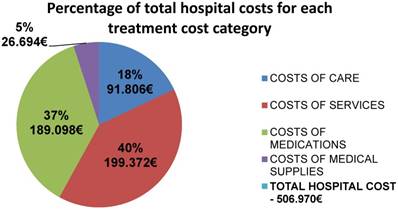
Percentage of total hospital costs for each treatment cost category in the first month of the diagnosis
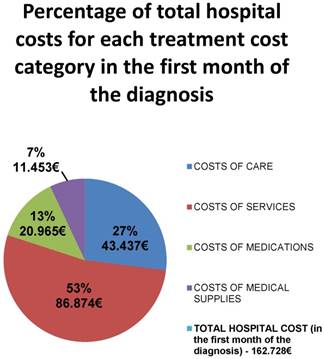
Mean cost of lung cancer treatment per patient by histologic type of lung cancer and cost type are shown in Table 4. Patients with adenocarcinoma have the highest mean costs of services (1.126€) and medications, with mean costs of medications (1.318€) being nearly three times higher than those of patients with diagnosed squamous (415€) or large cell carcinoma (441€). There is no statistically significant difference between histologic types of cancer regarding the type of cost in either of the cases.
Percentage of total hospital costs for each treatment cost category in months following the first month of treatment (in average 8.6 months)
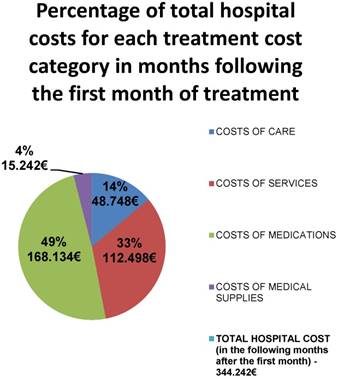
Hospital costs of lung cancer per patient - histologic type of lung cancer and cost type
| Type of cost and lung cancer Kruskal Wallis Test | N | Mean (€) | Minimum (€) | Maximum (€) | p-value | |
|---|---|---|---|---|---|---|
| CARE | Squamous | 46 | 462 | 116 | 1.253 | |
| Adeno | 123 | 493 | 11 | 2.264 | ||
| Large cell | 18 | 548 | 88 | 1.886 | 0.863 | |
| Total | 187 | 491 | 11 | 2.264 | ||
| SERVICES | Squamous | 46 | 921 | 155 | 2.822 | |
| Adeno | 123 | 1.126 | 36 | 6.438 | ||
| Large cell | 18 | 1.024 | 467 | 4.424 | 0.448 | |
| Total | 187 | 1.066 | 36 | 6.438 | ||
| MEDICATIONS | Squamous | 46 | 415 | 31 | 2.807 | |
| Adeno | 123 | 1.318 | 16 | 23.951 | ||
| Large cell | 18 | 441 | 34 | 1.214 | 0.651 | |
| Total | 187 | 1.011 | 16 | 23.951 | ||
| MEDICAL SUPPLIES | Squamous | 46 | 145 | 7 | 1.656 | |
| Adeno | 123 | 138 | 0.5 | 1.769 | ||
| Large cell | 18 | 174 | 4.9 | 1.675 | 0.666 | |
| Total | 187 | 143 | 0.6 | 1.769 | ||
| TOTAL | Squamous | 46 | 1.943 | 371 | 6.333 | |
| Adeno | 123 | 3.075 | 118 | 28.580 | ||
| Large cell | 18 | 2.186 | 908 | 9.199 | 0.449 | |
| Total | 187 | 2.711 | 118 | 28.580 | ||
Mean hospital costs of patients concerning the stage of cancer and cost type are shown in Table 5. The results of the entire group of 187 patients show no qualitative difference in costs between stages of cancer. However, p-values for cost of care, services, medications and medical supplies between stage IIIB and IV are 0.032, 0.020, 0.049 and 0.764 respectively, showing statistically significant differences of mean costs between these stages of cancer, except mean costs of medical supplies. In total, it is to conclude that there is statistically significant difference between costs of treatment for patients stage IIIB and patients stage IV lung cancer (p-value = 0.015), mainly due to the adenocarcinoma patients (p-value=0.005), since p-value for squamous carcinoma patients is 0.251.
Mean hospital costs of lung cancer per patient - stage of lung cancer and cost type
| STAGE | CARE | SERVICES | MEDICATIONS | MEDICAL SUPPLIES | TOTAL | |
|---|---|---|---|---|---|---|
| TOTAL in € (No of pts) | ||||||
| IIIB (N=69) | 534 | 1.159 | 951 | 158 | 2.802 | |
| IV (N=118) | 466 | 1.012 | 1.047 | 134 | 2.659 | |
| p-value | 0.032 | 0.020 | 0.049 | 0.764 | 0.015 | |
| SQUAMOUS | ||||||
| IIIB (N=19) | 479 | 962 | 421 | 90 | 1.952 | |
| IV (N=27) | 451 | 893 | 411 | 183 | 1.938 | |
| p-value | 0.390 | 0.289 | 0.144 | 0.192 | 0.251 | |
| ADENO | ||||||
| IIIB (N=42) | 584 | 1.327 | 1.319 | 202 | 3.432 | |
| IV (N=81) | 446 | 1.022 | 1.317 | 104 | 2.889 | |
| p-value | 0.010 | 0.011 | 0.015 | 0.097 | 0.005 | |
Analyzing patients with squamous cell carcinoma, large qualitative difference in mean costs between stage IIIB and stage IV is present in costs of medical supplies, where the mean cost of medical supplies in stage IV patients is nearly double than in stage IIIB patients. However, the Kruskall-Wallis test did not show any statistically significant difference in this group of costs. Taking other cost types in account, the data do not show any comparable difference. These conclusions are confirmed with p-values, also showing no statistically significant difference between costs for care, services and medications (p value = 0.390, 0.289 and 0.144 respectively).
Regarding patients with adenocarcinoma, no large qualitative differences between stages with regard to the mean cost types is seen. However, the results of Kruskall-Wallis test show statistically significant differences between stages of cancer in cost for care, services and medications except mean costs of medical supplies, with p-value being 0.010, 0.011 and 0.015 respectively. Statistically significant difference is also present between total costs of stage IIIB and stage IV adenocarcinoma (p-value = 0.005), in concordance with the noticeable qualitative difference (total mean cost of stage IIIB is 3.432€, and of stage IV 2.889€).
In Table 6 are shown mean hospital costs of lung cancer patients, differentiating patients` gender, age and cost type. Analyzing patients` gender, it is seen that the highest qualitative difference between male and female patients is present in mean costs of medications (ranging from 661€ for male patients to 1.972€ for female patients), but the obtained p-value does not confirm this observation, as it shows no statistically significant difference between this cost in male and in female patients (p-value = 0.548). However, statistically significant differences between male and female patients are present in mean costs of care (p-value = 0.048), services (p-value = 0.049) and medical supplies (p-value = 0.006). Despite these results, p-value shows no statistically significant difference for total mean costs (0.106).
Mean hospital costs of lung cancer per patient - gender, age and cost type
| TYPE OF COST: | CARE | SERVICES | MEDICATIONS | MEDICAL SUPPLIES | TOTAL |
|---|---|---|---|---|---|
| GENDER in Eu (No of pts) | |||||
| MALE (N=137) | 446 | 946 | 661 | 117 | 2.170 |
| FEMALE (N=50) | 615 | 1.395 | 1.972 | 214 | 4.196 |
| p-value | 0.048 | 0.049 | 0.548 | 0.006 | 0.106 |
| AGE in Eu (No of pts) | |||||
| ≤ 65 (N=109) | 510 | 1.156 | 1.061 | 166 | 2.893 |
| > 65 (N=78) | 464 | 940 | 942 | 111 | 2.457 |
| p-value | 0.588 | 0.136 | 0.304 | 0.913 | 0.171 |
Having divided the patients into two age groups: ≤65 years of age and >65 years of age, the results of Mann-Whitney test showed no statistically significant differences between these two age groups in any of the mean costs. As far as the total cost is concerned, p-value being at the level 0.171, it is to conclude that there is no statistically significant difference between patients` age and cost of treatment.
Hospital costs of treating four patients who received TKI therapy are shown in Table 7. Clearly, the highest of all costs is the cost of medications, with the average of approximately 21.000€ per patient. Costs of services in patients who received erlotinib are higher than in patients who received gefitinib. On the average, patients receiving TKI therapy cause nearly 25.000 € worth of medical costs, of which almost 85% is the cost of medications.
Hospital costs of treating patients who received erlotinib or gefitinib
| TYPE OF COST: | CARE | SERVICES | MEDICATIONS | MEDICAL SUPPLIES | TOTAL |
|---|---|---|---|---|---|
| Patient 1 (gefitinib) | 504 | 1.276 | 22.056 | 111 | 23.947 |
| Patient 2 (gefitinib) | 1.168 | 1.993 | 22.356 | 321 | 25.838 |
| Patient 3 (erlotinib) | 1.190 | 2.998 | 23.951 | 441 | 28.580 |
| Patient 4 (erlotinib) | 1.454 | 2.891 | 16.569 | 196 | 21.110 |
Discussion
In this single center study, hospital costs of lung cancer diagnosis and treatment in 187 patients who were diagnosed and treated in Institute for Pulmonary Diseases of Vojvodina, in the period from 01 January 2013 to 30 June 2015 (30 months in total) were assessed. Only patients diagnosed with NSCLC in stages IIIB and IV were taken into account.
The results of this study show that there is a statistically significant difference between patients in stage IIIB and stage IV NSCLC concerning their survival, where patients in stage IV have less time ahead of them, mainly due to the rapid disease progression. These findings are consistent with those presented in similar studies [11, 12], where longer survival rate for stage IIIB patients was also confirmed. Survival analysis was performed due to the possible influence of the duration of the treatment to the treatment costs. Patients who have longer survival time, in other words, patients in stage IIIB NSCLC, cause higher hospital costs. Mean hospital costs show statistically significant difference between patients in stages IIIB and IV, in every aspect of those costs except for the cost of medical supplies. Therefore we conclude that the longer survival time, in other words patients in stage IIIB, generates more hospital costs, mainly due to the prolonged treatment of the disease. Furthermore, difference of the treatment costs between adenocarcinoma and squamous carcinoma due to the treatment of some adenocarcinoma patients with novel drugs (TKI), and a higher number of stage IV among patients with adenocarcinoma comparing to squamous cell carcinoma, as an overall result gives such a difference between stage IIIB and stage IV, as well as a longer survival of patients with stage IIIB.
Our conclusion about this matter is consistent with the findings of other studies, when costs of surgery and radiotherapy are excluded, since our study did not analyze these costs.[13, 14] However, many other studies have concluded the opposite - costs of treating patients with stage IV lung cancer are higher than of patients stage IIIB.[15-17] Comparing costs of chemotherapy and hospitalization (services and care), as the two main cost components in these studies (conducted by Arrieta et al, Corral et al. and Kang et al. respectively), with the ones in our study, higher costs are seen in patients stage IV compared to patients stage IIIB NSCLC. Moreover, in these studies, costs of chemotherapy for stage IV NSCLC are nearly double than for stage III NSCLC, which is not the case with our results. As far as the cost of hospitalization is concerned, in countries where these studies were conducted, the price of a daily bed for patients is much higher than in our country. In other words, the results of some of the mentioned studies show the highest cost of hospitalization, followed by cost of chemotherapy and other costs.[13, 14, 17, 18]
When analyzing survival time between male and female patients, we have come to the conclusion that female patients have longer survival time than male patients (Mantel-Cox test - p-value 0.045). Many other studies, which analyzed this matter, came to the same conclusion. Longer survival in female patients entails larger costs of treatment, or in other words, cost of care, services, medication and medical supplies.[11, 18-20] There is statistically significant difference between male and female patients in each type of costs but the costs of medications, where despite the larger mean hospital cost per female patient, there is no statistically significant difference between this cost and the same cost for male patients.
Regarding the age of the patients enrolled in our study, we have divided them into two groups: patients under and 65 years and patients over 65 years of age. Observing these two groups, no statistically significant difference is seen between them in terms of any of the costs measured in our study. Therefore, as a conclusion, patient's age is not a relevant factor which influences on the amount of money spent on the diagnosis and treatment of the disease.
Out of 123 patients who were diagnosed with adenocarcinoma, four of them were diagnosed as EGFR positive and therefore were adequate candidates for receiving TKI therapy (in our study these patients received gefitinib or erlotinib). When assessing mean hospital costs for these four patients, the greatest difference which separates them from the other 119 patients with adenocarcinoma is the cost of medications. The mean cost of medication for all 123 patients is 1.318€, and the mean cost for EGFR positive patients is 21.233€. This data allows us to assess the high cost of biological therapy. Moreover, this difference is even better seen when comparing the costs for EGFR positive patients with the rest of the patients (183 of them). In other words, out of the total hospital cost for medications (189.098 €), nearly half the amount is contributed to patients treated with TKI therapy (84.932€). Average cost of 30-month treatment for NSCLC mutation negative patients was 2.227€, and for mutation positive (EGFR positive) patients the average cost was 24.869€ - nearly ten times higher. According to this data, it is to conclude that the biological (TKI) therapy for treating lung cancer is highly expensive, compared to classical chemotherapy.
Differentiating the costs which occurred in the first month of the diagnosis from those of the following months is also of great importance. Although the difference between these two groups is not that high when it comes to costs of care, services or medical supplies, we see an enormous distinction when costs of medications are concerned. These costs are nearly eight times higher in the following months than in the first month of the diagnosis, all mainly because of the treatment and the therapy the patients received in months following the diagnosis and up until their death. Other studies also came to a similar conclusion about this matter as we did.[21] Analysis of costs per unit of time was not conducted; hence the interest in our study was on determining the average patient costs, regardless of the time of their treatment.
Conclusion
This study provides the cost of treatment for stage IIIB and IV non-small cell lung cancer in single tertiary healthcare institution in Vojvodina, Serbia. Costs of services and medications (chemotherapy) were the most important components of costs. Costs of radiotherapy treatments and surgical interventions were not taken into account. Biological therapy for treating lung cancer is highly expensive, comparing to classical chemotherapy. This cost analysis can be considered as a baseline study that provides useful information for future studies on the budget impact of different therapeutic approaches in lung cancer treatment in Serbia.
Acknowledgements
Funding: This work was supported by the National Natural Science Foundation of China (Grant No: 81370136).
Competing Interests
The authors have declared that no competing interest exists.
References
1. Global Burden of Disease Cancer C, Fitzmaurice C, Dicker D, Pain A, Hamavid H, Moradi-Lakeh M. et al. The Global Burden of Cancer 2013. JAMA oncology. 2015;1:505-27 doi:10.1001/jamaoncol.2015.0735
2. Ferlay J, Steliarova-Foucher E, Lortet-Tieulent J, Rosso S, Coebergh JW, Comber H. et al. Cancer incidence and mortality patterns in Europe: estimates for 40 countries in 2012. European journal of cancer. 2013;49:1374-403 doi:10.1016/j.ejca.2012.12.027
3. Ferlay J, Soerjomataram I, Dikshit R, Eser S, Mathers C, Rebelo M. et al. Cancer incidence and mortality worldwide: sources, methods and major patterns in GLOBOCAN 2012. International journal of cancer. 2015;136:E359-86 doi:10.1002/ijc.29210
4. Molina JR, Yang P, Cassivi SD, Schild SE, Adjei AA. Non-small cell lung cancer: epidemiology, risk factors, treatment, and survivorship. Mayo Clinic proceedings. 2008;83:584-94 doi:10.4065/83.5.584
5. Gibson GJ, Loddenkemper R, Lundback B, Sibille Y. Respiratory health and disease in Europe: the new European Lung White Book. The European respiratory journal. 2013;42:559-63 doi:10.1183/09031936.00105513
6. Organization WH. World Health Statistics 2011. World Health Organization: World Health Organization. 2011 2011
7. Howlader N NA, Krapcho M. et al. editors. National Cancer Institute. SEER Cancer Statistics Review, 1975-2008. Bethesda: National Cancer Institute. 2010
8. Arca JA, Ramos MA, de la Infanta RG, Lopez CP, Perez LG, Lopez JL. [Lung cancer diagnosis: hospitalization costs]. Archivos de bronconeumologia. 2006;42:569-74
9. Hirsh V. Systemic therapies in metastatic non-small-cell lung cancer with emphasis on targeted therapies: the rational approach. Current oncology. 2010;17:13-23
10. Spiro SG, Tanner NT, Silvestri GA, Janes SM, Lim E, Vansteenkiste JF. et al. Lung cancer: progress in diagnosis, staging and therapy. Respirology. 2010;15:44-50 doi:10.1111/j.1440-1843.2009.01674.x
11. Asamura H, Goya T, Koshiishi Y, Sohara Y, Eguchi K, Mori M. et al. A Japanese Lung Cancer Registry study: prognosis of 13,010 resected lung cancers. Journal of thoracic oncology: official publication of the International Association for the Study of Lung Cancer. 2008;3:46-52 doi:10.1097/JTO.0b013e31815e8577
12. Detterbeck FC, Boffa DJ, Tanoue LT. The new lung cancer staging system. Chest. 2009;136:260-71 doi:10.1378/chest.08-0978
13. Fleming I, Monaghan P, Gavin A, O'Neill C. Factors influencing hospital costs of lung cancer patients in Northern Ireland. The European journal of health economics: HEPAC: health economics in prevention and care. 2008;9:79-86 doi:10.1007/s10198-007-0047-4
14. Dedes KJ, Szucs TD, Bodis S, Joerger M, Lowy A, Russi EW. et al. Management and costs of treating lung cancer patients in a university hospital. PharmacoEconomics. 2004;22:435-44
15. Arrieta O, Quintana-Carrillo RH, Ahumada-Curiel G, Corona-Cruz JF, Correa-Acevedo E, Zinser-Sierra J. et al. Medical care costs incurred by patients with smoking-related non-small cell lung cancer treated at the National Cancer Institute of Mexico. Tobacco induced diseases. 2014;12:25. doi:10.1186/s12971-014-0025-4
16. Corral J, Espinas JA, Cots F, Pareja L, Sola J, Font R. et al. Estimation of lung cancer diagnosis and treatment costs based on a patient-level analysis in Catalonia (Spain). BMC health services research. 2015;15:70. doi:10.1186/s12913-015-0725-3
17. Kang S, Koh ES, Vinod SK, Jalaludin B. Cost analysis of lung cancer management in South Western Sydney. Journal of medical imaging and radiation oncology. 2012;56:235-41 doi:10.1111/j.1754-9485.2012.02354.x
18. Schwarzkopf L, Wacker M, Holle R, Leidl R, Gunster C, Adler JB. et al. Cost-components of lung cancer care within the first three years after initial diagnosis in context of different treatment regimens. Lung cancer. 2015;90:274-80 doi:10.1016/j.lungcan.2015.09.005
19. Nakamura H, Ando K, Shinmyo T, Morita K, Mochizuki A, Kurimoto N. et al. Female gender is an independent prognostic factor in non-small-cell lung cancer: a meta-analysis. Annals of thoracic and cardiovascular surgery: official journal of the Association of Thoracic and Cardiovascular Surgeons of Asia. 2011;17:469-80
20. Fu JB, Kau TY, Severson RK, Kalemkerian GP. Lung cancer in women: analysis of the national Surveillance, Epidemiology, and End Results database. Chest. 2005;127:768-77 doi:10.1378/chest.127.3.768
21. Demeter SJ, Jacobs P, Chmielowiec C, Logus W, Hailey D, Fassbender K. et al. The cost of lung cancer in Alberta. Canadian respiratory journal. 2007;14:81-6
Author contact
![]() Corresponding author: Paul Zarogoulidis, M.D, Ph.D, Pulmonary-Oncology Unit, ''Theageneio'' Cancer Hospital, Thessaloniki, Greece. Mobile: 00306977271974; E-mail: pzarogcom
Corresponding author: Paul Zarogoulidis, M.D, Ph.D, Pulmonary-Oncology Unit, ''Theageneio'' Cancer Hospital, Thessaloniki, Greece. Mobile: 00306977271974; E-mail: pzarogcom

 Global reach, higher impact
Global reach, higher impact